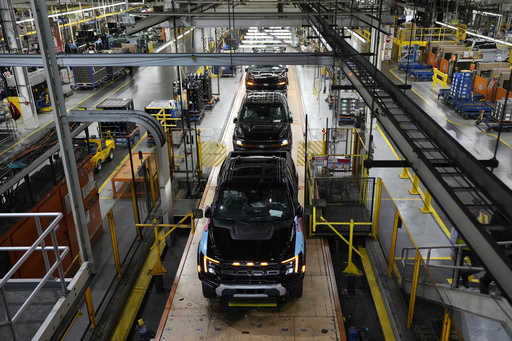WASHINGTON (AP) — Wholesale price increases fell in May, the latest sign that inflation pressures in the United States may be easing as the Federal Reserve considers a timetable for cutting interest rates.
The Labor Department reported Thursday that its producer price index — which tracks inflation before it reaches consumers — declined 0.2% from April to May after rising 0.5% the month before, pulled down by a 7.1% plunge in gasoline prices. Overall, it was the biggest drop in producer prices since October.
Measured from a year earlier, wholesale prices were up 2.2% last month, edging down from a 2.3% increase in April. Excluding volatile food and energy costs, so-called core producer prices were unchanged from April and up 2.3% from May 2023.
Wholesale food prices dropped 0.1% from April to May. Egg prices dropped 35%. Computer and computer equipment fell 1.2%, and household appliance prices slid 0.5%.
The producer price index can provide an early read on where consumer inflation is headed. Economists also watch it because some of its components, including some healthcare and financial services costs, are used to compile the Fed’s preferred inflation gauge, known as the personal consumption expenditures price (PCE) index.
The wholesale figures were released a day after the Labor Department reported that consumer inflation eased in May for a second straight month. Core consumer prices rose 0.2% from April to May, the smallest increase since October. And compared with May 2023, core prices rose 3.4%, the mildest such increase in three years.
Consumer inflation peaked at 9.1% two years ago but came down as the Fed raised its benchmark interest rate 11 times in 2022 and 2023, taking it to a 23-year high. Still, it continues to run above the Fed’s 2% target.
Yet combined with Wednesday’s mild consumer inflation report, Thursday’s wholesale data offered an encouraging sign that an acceleration of prices that occurred early this year may have passed.
“Inflation took two steps in the right direction last month after surprising to the upside in early 2024,’’ Bill Adams, chief economist at Comerica Bank, said in a research note. “The PPI report reinforces expectations for a soft print of the Fed’s preferred measure of inflation.’’
Paul Ashworth, chief North America economist at Capital Economics, suggested that last month’s wholesale inflation figures mean that the May PCE price index, due June 28, will barely rise at all.
On Wednesday, after it ended its latest policy meeting, the Fed said that it was leaving its benchmark rate unchanged and projected that it would make only one rate cut this year, down from its previous forecast of three cuts in 2024. Most economists think the first rate cut is most likely to occur in September.
“This kind of (inflation) performance, coupled with continued favorable performances over the next few months is what is needed, in our opinion, for a September Fed rate cut to occur,’’ said Sam Bullard, senior economist at Wells Fargo.
Even as inflation moderates, such necessities as groceries, rent and health care are much pricier than they were three years ago — a continuing source of public discontent and a political threat to President Joe Biden’s re-election bid.
Yet despite the lingering inflation pressures and higher borrowing costs, the U.S. economy remains resilient . Businesses are hiring. Unemployment remains low, giving Americans unusual job security. The World Bank just upgraded its forecast for U.S. economic growth this year to 2.5% from 1.6% — a markup so big that it lifted the bank’s outlook for the entire global economy.
This website uses cookies so that we can provide you with the best user experience possible. Cookie information is stored in your browser and performs functions such as recognising you when you return to our website and helping our team to understand which sections of the website you find most interesting and useful.
